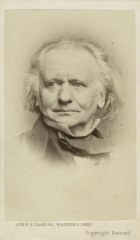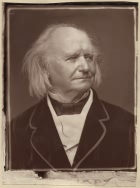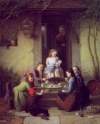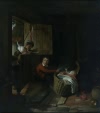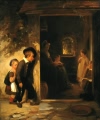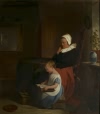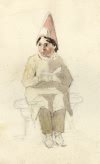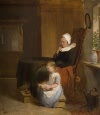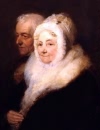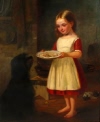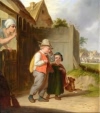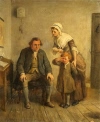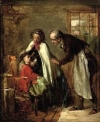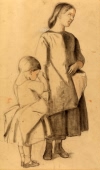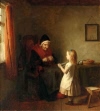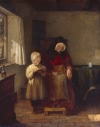Date
Type
Information
Source
20th Mar 1800
Born
At Ranelagh Street in the Parish of Pimlico, London
9th May 1800
Christened
At St. Margaret's Church in the Parish of Westminster, London
Mick Henry's research
10th May 1847
Married
At Cookham cum Ewshott in the County of Hampshire; registered at Hartley Wintney District, Hampshire; ref: 1847 Q2 Vol 7 Page 147
Kathleen Rhys' research
26th Jul 1860
Married
At All Souls in the Parish of Marylebone, London; witnessed by J.C. Horsley, Charles Vinall and Marian Summerfield
London Metropolitan Archives
23rd Sep 1886
Died
In the Parish of Cranbrook, Kent
after 23rd Sep 1886
Buried
At St Dunstan's Church in the Parish of Cranbrook, Kent; memorial by Hamo Thorneycroft
23rd Oct 1886
Will
Personal estate £18,705 9s 2d
Probate Registry of England and Wales
1857 to 1886
Home
At Webster House in the Parish of Cranbrook, Kent
3rd Apr 1881
Census
At High Street in the Parish of Cranbrook, Kent; Thomas Webster, M, Head, married, age 81, born London; occupation: Artist painter R.A.
1881 Census
Cranbrook, Kent
1884
Thomas Webster at Webster House, Cranbrook photographed by Joseph Parkin Mayall
Private collection
1876
A Birthday Tea Party, Oil (27" x 22") painted by Thomas Webster
0
1845
A Dame's School, Oil on Mahogany painted by Thomas Webster, exhibited at the Royal Academy
0
1852
A Letter from the Colonies, Oil on panel (15 x 15 cm) painted by Thomas Webster, exhibited at the Royal Academy
Private collection
1863
A Tea Party, Oil on panel (50.8 x 61 cm) painted by Thomas Webster, exhibited at the Royal Academy
Harris Museum and Art Gallery, Preston, Lancashire
before 1850
Beating for Recruits, Oil on mahogany panel (44.5 x 39.4 cm) painted by Thomas Webster
Victoria and Albert Museum, London
c 1865
Thomas Webster painted by Elliott and Fry
0
1835
Children at Prayer, Oil on panel (49.5 x 59.6 cm) painted by Thomas Webster
Victoria and Albert Museum, London
1843
Contrary Winds, Oil on mahogany panel (37.3 x 57.1 cm) painted by Thomas Webster
Victoria and Albert Museum, London
1843
Sickness and Health, Oil on panel (50.7 x 81 cm) painted by Thomas Webster, exhibited at the Royal Academy
Victoria and Albert Museum, London
1834
Late at School, Oil on Mahogany painted by Thomas Webster
0
1878
Maternal Affection, Oil on canvas (88.5 x 79 cm) painted by Thomas Webster
Private collection
before 1870
Reading the News, Oil on board (21.6 x 16.5 cm) painted by Thomas Webster
Private collection
c 1835
Reading the Scriptures, Oil on panel (40.6 x 35.5 cm) painted by Thomas Webster
Victoria and Albert Museum, London
1862
Roast Pig, Oil on canvas (73 x 118.5 cm) painted by Thomas Webster, exhibited at the Royal Academy
Sheffield Galleries and Museum Trust
1841
Schoolboy painted by Thomas Webster
0
before 1870
Sunday Afternoon, Oil on panel (21.6 x 19.1 cm) painted by Thomas Webster
Wolverhampton Art Galery
1844
The Artist's Parents, Oil on Wood painted by Thomas Webster, exhibited at the Royal Academy
0
1831
The Lesson, Oil on panel (38.1 x 58.3) painted by Thomas Webster
Victoria and Albert Museum, London
1847
A Village Choir, Oil on panel (60.4 x 91.5 cm) painted by Thomas Webster, exhibited at the Royal Academy
Victoria and Albert Museum, London
1842
The Boy With Many Friends, Oil painted by Thomas Webster, exhibited at the Royal Academy
Bury Art Gallery and Museum, Lancashire
1845 to 1865
A Musical Evening, Oil on canvas (50.5 x 60.5 cm) painted by Thomas Webster
Private collection
1852
School Playground, Oil on canvas (76 x 151 cm) painted by Thomas Webster, exhibited at the Royal Academy
Private collection
1845 to 1865
Boys will be Boys, Oil on canvas (51 x 64 cm) painted by Thomas Webster
Private collection
1845 to 1865
Classroom Recital, Watercolour (30 x 60 cm) painted by Thomas Webster
Private collection
1867
Cottagers Making Music - A Musical Evening, Oil on canvas (55.9 x 87.6 cm) painted by Thomas Webster
Private collection
1881
Girl Feeding Dog, Oil on canvas (35.5" x 27.3") painted by Thomas Webster
Private collection
1842
Going to School, Oil on panel (69.2 x 104.8 cm) painted by Thomas Webster, exhibited at the Royal Academy
Private collection
1837
Going to the Fair, Oil on canvas (55.9 x 76.1 cm) painted by Thomas Webster
Victoria and Albert Museum, London
1847
Goodnight!, Oil on panel (71.4 x 118.7 cm) painted by Thomas Webster, exhibited at the Royal Academy
Bristol City Museum and Art Gallery
1837
Returning from the Fair, Oli on canvas (55.9 x 76.1 cm) painted by Thomas Webster, exhibited at the Royal Academy
Victoria and Albert Museum, London
c 1850
Ring o' Roses, Oil on panel (30.5 x 40.6 cm) painted by Thomas Webster
Paul Mellon Collection, Yale Center for British Art, USA
1842
Sketch for 'The Boy With Many Friends' drawn by Thomas Webster
Bury Art Gallery and Museum, Lancashire
1842
Sketch for 'The Boy With Many Friends' drawn by Thomas Webster
Bury Art Gallery and Museum, Lancashire
1849
See-saw, Oil on panel painted by Thomas Webster, exhibited at the Royal Academy
CityMuseum
1858
Sunday Evening, Oil painted by Thomas Webster, exhibited at the Royal Academy
0
1845 to 1865
The Chastened Child, Oil on panel (36 x 30 cm) painted by Thomas Webster
Private collection
1847
The Naughty Pupil, Oil on canvas (12.3" x 10.3") painted by Thomas Webster
Private collection
1850
The Playground, Oil on panel (19" x 36") painted by Thomas Webster
CityMuseum
1835
This Won't Hurt a Bit!, Oil on panel (17.8 x 14.6 cm) painted by Thomas Webster
Private collection
1845 to 1865
Two Young Girls, Oil painted by Thomas Webster
0
1845 to 1865
Victorian Country Classroom, Oil painted by Thomas Webster
0
1865
Village Gossips, Oil on canvas (20" x 30") painted by Thomas Webster, exhibited at the Royal Academy
Private collection
1876
Youth and Age, Oil on panel (45.7 x 40.9 cm) painted by Thomas Webster, exhibited at the Royal Academy
Private collection
1842
The Frown, Oil on panel (31.7 x 63.5 cm) painted by Thomas Webster, exhibited at the Royal Academy
CityMuseum
1845 to 1865
The New Sign, Oil on canvas (70 x 90 cm) painted by Thomas Webster
Blackburn Museum and Art Gallery, Lancashire
1846
The Early lesson, Oil on canvas (52.1 x 41.9 cm) painted by Thomas Webster
Royal Academy of Arts, London
1842
The Smile, Oil on panel (31.7 x 63.5 cm) painted by Thomas Webster
CityMuseum
1839
The Football Game, Oil on canvas (73.5 x 99.5 cm) painted by Thomas Webster, exhibited at the Royal Academy
Private collection
c 1865
Thomas Webster, albumen carte-de-visite (9.1 x 5.7cm) photographed by John & Charles Watkins
© National Portrait Gallery - reference NPG Ax11929
Thomas Webster, R.A., was born on the 20th of March, 1800, in Ranelagh Street, Pimlico; his father, being attached to the household of George III., took his child in its infancy to Windsor, where he remained till the death of the venerable monarch. Young Webster was educated in the choir of the Chapel Royal, St. James's, his father being desirous of making a chorister of him; but like Hoppner, who was in the choir of the Chapel Royal, and Callcott in that of Westminster Abbey, Webster preferred the art of painting to the practice of music. We know not what the world has lost as a vocalist by the preference, but we are sure it has thereby gained an original and most excellent painter.
Whether, as a boy, Mr. Webster took more delight in 'Going into School', or in 'Coming out of School'; whether he stood in awe of the Dominie's 'Frown', and laughed at his 'Joke'; whether he was one of the party of 'Birdcatchers', joined in the 'Gunpowder Plot', and was the lucky 'Boy who had many Friends' — of these and other matters of like import we are in profound ignorance, and must leave our readers in the same condition; but we will venture to assert that in all the sports he has so aptly represented on his canvases, he played his part, and from them stored his youthful mind with recollections that have answered the purpose of his after life better than the 'Commentaries' of Caesar, if he ever read them, or the distractions of duodecimals and algebraic problems, if he ever worked them out on his oak-framed slate.
In 1820 he entered the Royal Academy as a student, and in 1825 obtained the first medal in the School of Painting. Having, in 1825, been fortunate in painting a little picture entitled 'Rebels shooting a Prisoner,' exhibited at Suffolk Street, it at once brought him into notice, so that the difficulties which many young painters find in early life, and their consequent privations, were alike unfelt by him; these difficulties and privations are arduous and painful enough to check all except the most ardent spirits, but when once surmounted, he who has overcome regards them from his vantage-ground with unqualified satisfaction.
The first of his exhibited pictures of which we possess any record, except that just mentioned, was one sent to the Royal Academy in 1827, a portrait-picture, we presume, the 'Children of T. Drane, Esq.'; the next year he contributed the 'Gunpowder Plot' to the Academy, and in 1829, 'The Prisoner', and 'A Foraging Party roused', to the British Institution. Of these and earlier works which Mr. Webster forwarded to our public galleries, we can only give the titles; our space does not admit of detailed comment. For the next ten years we find him exhibiting one or two pictures annually, either at the British Institution or at the Academy, the year 1834 only excepted.
All this time the artist was gradually winning his way to public favour; every class saw in his humorous compositions what could not fail to amuse, and therefore to please; for his humour, like that of all Dickens's droll fellows, is never coarse; it never touches caricature. His characters are invariably true to nature, though in her most ludicrous aspect - nature which both old and young can understand and appreciate.
At the period of which we are writing, it was a common practice with artists — especially such as had achieved a reputation — to send to the British Institution only pictures which had been previously exhibited at the Academy, but we do not find that Mr. Webster followed this plan; he contributed to this society, in 1839, two pictures - one 'The Rat-Trap', boys inspecting its contents; the other called 'Anticipation', a baker's lad bringing home a pie, for which a hungry-looking boy waits anxiously at the door of his cottage home, standing "like a greyhound in the slip," with a cloth tucked up under his chin, a spoon in his hand, his mouth half-open in "anticipation" of the savoury plateful. His Academy picture of this year, 'Football', was considered the best he had yet painted; a group of village urchins are in the full excitement of the game, which they follow up in the most vigorous manner. Of course Mr. Webster must show some "fun" among the players; consequently, a boy has received a kick, and in his agony seizes one of his companions by the hair; another boy has had his cap pressed over his eyes by some mischief-lovers; while another, who is kneeling in the foreground of the composition, rubs himself to relieve the pain occasioned by a chance blow given in the mélée. The picture is full of animation, the figures are most skilfully grouped, and very carefully finished.
In the following year, 1841, the name of Mr. Webster appears in the list of Associates of the Royal Academy, an honour to which he had proved a just claim; he was elected with Sir Charles Barry and Mr. Redgrave. He exhibited three pictures this year, and they were three which we think he has never surpassed. Two of them, 'The Smile' and 'The Frown', are well known from the engravings published by the "Art Union of London", while there must be few people whose attention has not been at some time or other drawn to an engraving of 'The Boy with many Friends', - the schoolboy with his half-opened package of good things from home, surrounded by his schoolfellows each anxious to lend knife, corkscrew, or anything else that will oblige the owner of the untold treasure.
There was a charming little picture by this artist, occupying the "post of honour", as the position over the fireplace was generally considered, in the British Institution in 1842; it was called the 'Wanderer', and represented a young Italian boy with a box of white mice, which he is showing to some children at the door of their cottage. The contrast in the faces of 'The Wanderer', weary and exiled, and those of the children in humbler but comfortable quarters at home, is very happily expressed - the group all sunshine and delight, the little Italian sorrowful and careworn.
Mr. Webster's single picture of the year 1843, we will venture to say, drew forth as many sighs from the spectators as his former productions had elicited smiles; it portrayed one of those touching incidents which show that the artist's harp is not always tuned to merriment, but that sometimes it hangs upon the willows; the picture is called 'Sickness and Health'. A young girl on whose features the death-warrant is set is seated propped up by pillows at a cottage door; before it an Italian organ-grinder is playing his instrument, to the music of which two children, younger than the poor invalid, are dancing; all the characters very ably sustain the intention of the artist, and are full of interest.
What would Mr. Webster have done for subjects for his pencil had there been no such folk in the world as incorrigible boys, idle boys, mischievous boys, funny boys, &c.? Yet in one of his two Academy pictures of 1844, the artist stepped aside from his usual course to pay a tribute of filial affection to his aged parents by painting their portraits to commemorate the fiftieth anniversary of their marriage; the aged couple are seated side by side. The picture, a small one, is a gem of its class. In the following year Mr. Webster was elected Royal Academician; his sole contribution to the exhibition was 'The Dame's School', now in the Vernon collection; a large engraving of this picture has been published by Mr. Hogarth, and a small one appeared in the Art Joiirnal some years ago.
An important and most amusing picture was exhibited by Mr. Webster in 1847; it was suggested by a description in one of the tales in Washington Irving's inimitable 'Sketch-Book', where Frank Bracebridge promises to favour his friends with a specimen of the musical achievement of his cousin Simon in forming a 'Village Choir', in the church which did not possess an organ; Simon, for this purpose, had formed a choir of all the parish vocalists and instrumentalists, selecting "for the bass all the deep solemn mouths, and for the tenor the loud ringing mouths, among the country bumpkins." In the gallery of the church, therefore, is about as motley an assemblage of choristers as can well be imagined; the leader of the choir, a spare figure in an ill-fitting suit of rusty black, is singing most lustily, his open mouth discovering the loss of so many of his teeth as must make his intonation far from distinct; to the right and left of the leader are ranged the vocalists - anything but "sweet singers of Israel," and the performers on bassoon, violoncello, clarionet, &c., each of whom is unquestionably extracting as much "power" from his instrument as lungs and a strong arm can respectively produce. The composition is full of humorous incident, carried out with the careful execution which has always distinguished the style of this painter.
Amongst his more recent works we may notice - we have not space for more than the titles - 'Politicians', exhibited in 1869; 'Volunteers at Artillery Practice', in 1871; 'An Interested Adviser', in 1873; 'The Wreck Ashore', in 1874; 'Youth and Age', in 1876; 'The Letter', in 1877; a Portrait of Himself, in 1878. He was placed on the list of Honorary Retired Academicians in 1877. A lifetime of such incessant labour may seem to have deserved an evening of calm repose; yet such is his fondness for Art that the silver-haired octogenarian is even now working in his quiet retreat at Cranbrook, using to the utmost the talents intrusted to his care. Can we say that his "pound" has not produced its ten pounds?
We confess a strong partiality for the inimitable works of this most original painter; they are pictures affording real pleasure; whether we regard their masterly execution as artistic productions, or the cheerful and amusing subjects he illustrates, they are equally most acceptable
Extract from British Painters published in 1881
